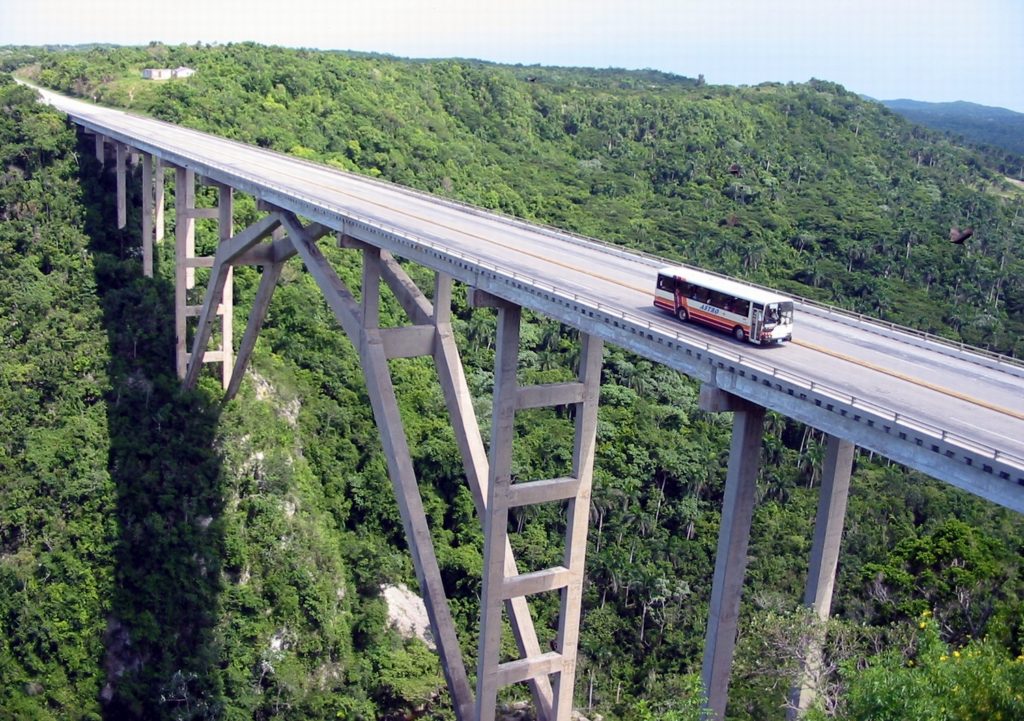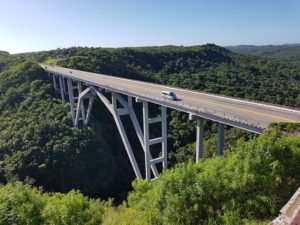EL PUENTE DE BACUNAYAGUA, MATANZAS, CUBA, UNA COLOSAL OBRA DE INGIENERIA. PHOTOS/VIDEOS
El puente más alto de la isla caribeña de Cuba, el puente de Bacunayagua es un puente de arco poligonal elegante y elegante con dos tramos de costilla que consta de 4 vigas de hormigón cónicas. Un área de observación ofrece excelentes vistas del puente.
Iniciada su construcción en 1956 bajo el último presidente electo cubano Carlos Prío, la Provincia de Matanzas tuvo la oportunidad de inaugurar el puente más largo y más alto de Cuba.
Los cubanos la consideran una de las siete maravillas de la ingeniería civil cubana. Fue diseñado por Luis Sáenz Duplace y construido bajo la dirección del Ingeniero Civil Manuel (Manolo) Arvest. Aunque Bacunayagua fue el punto culminante de su carrera, el ingeniero cubano Luis Sáenz diseñó varios puentes en Cuba que demostraron su talento con el concreto, incluido el puente de arco del río Canimar, el puente de vigas postesadas de Cuyaguateje y el puente de marco Tuinicu.
 VIDEOS- El Puente de Bacunayagua…
VIDEOS- El Puente de Bacunayagua…
Nacido en La Habana, Sáenz recibió su título de ingeniero civil de la Universidad de La Habana y una licenciatura en Ingeniería Metalúrgica del Instituto Politécnico de Brooklyn antes de iniciar una firma de ingeniería arquitectónica en varios países centroamericanos. Trabajó principalmente en las oficinas de San Juan, Puerto Rico y Miami, Florida. Se decía que Sáenz siempre comenzaba sus diseños con un boceto preciso a mano alzada para mantener sus puentes livianos y estéticamente agradables.
UNA COLOSAL OBRA DE INGENIERÍA
Construido en los límites de la provincia de La Habana y Matanzas, su construcción es históricamente un cruce con la Vía Blanca (la carretera que conecta Ciudad de La Habana y Varadero), con el propósito de acortar la distancia entre Matanzas y La Habana. Un total de 41 columnas sostienen el puente de Bacunayagua, las que en su momento fueron las más esbeltas del mundo hechas de hormigón.
En 1956 se iniciaron las obras de construcción del puente, catalogado en esa época como una obra colosal, no sólo por su extensión sino por la altura sobre un inmenso acantilado. Sus columnas poseen una pila de 22,50 metros cada una, con un ancho de un metro por 1,60 metros, y algunas alcanzan los 42 metros de altura.
Sobre sus cabezales se encuentran 6 vigas que pesan cada una 47 toneladas, y fueron fusionadas en el mismo lugar donde se construía el puente. En total, el puente tiene una altura de 103 metros, con una longitud de 314 metros y un ancho de 17. No fue terminado hasta octubre de 1959, cuando se fijó oficialmente la apertura de las vías para la comunicación entre La Habana y Matanzas.
Este imponente paso se encuentra a 18 kilómetros al oeste de la ciudad de Matanzas y establece el límite territorial con la provincia de La Habana. Al norte del puente, se divisa el inmenso mar; el cauce y desembocadura de lo que debió ser el cauce de un caudaloso río en tiempo remoto, y al sur, el extenso y exuberante Valle de Yumurí.
La importancia de ese cruce para la Vía Blanca reside en que es la conexión más cercana y directa, para el hermoso paisaje de la costa norte cubana, entre el Túnel de la capital del país y la Ciudad Balneario de Varadero.
La belleza del entorno de Bacunayagua, favorecida por la ejecución de ese avanzado proyecto, alterna con multitud de farallones, laderas y manglares, refugio natural de gran importancia ornitológica donde conviven 74 especies de aves, 16 reptiles y ocho anfibios. En el ecosistema de la ciénaga de esta zona aparecen formaciones vegetales como el brezal costero xeroforme y la selva semicaducifolia, además de una rica y variada fauna con un alto porcentaje de endemismo.
La magnitud y espléndida imagen del lugar se puede apreciar perfectamente desde el Mirador, ubicado en un alzado al extremo oeste de la maravillosa obra.
THE BACUNAYAGUA BRIDGE, MATANZAS, CUBA, IS A COLOSSAL WORK OF ENGINEERING. PHOTOS/VIDEOS
The highest bridge on the Caribbean island of Cuba, the Bacunayagua bridge is a stylish and classy polygonal arch bridge with two rib spans consisting of 4 tapered concrete beams. An observation area offers great views of the bridge.
Started its construction in 1956 under the last Cuban elected president Carlos Prio, the Province of Matanzas had the opportunity to inaugurate the longest and highest bridge in Cuba.
Cubans consider it one of the seven wonders of Cuban civil engineering. It was designed by Luis Sáenz Duplace and built under the leadership of Civil Engineer Manuel (Manolo) Arvest. Although Bacunayagua was the highlight of his career, Cuban engineer Luis Saenz designed several bridges in Cuba that showed his talent with concrete including the Canimar River arch bridge, the Cuyaguateje post-tensioned beam bridge, and the Tuinicu frame bridge.
Born in Havana, Saenz received his civil engineering degree from the University of Havana and a BS in Metallurgical Engineering from the Polytechnic Institute of Brooklyn before starting an architectural engineering firm in several Central American countries. He primarily worked out of the San Juan, Puerto Rico, and Miami, Florida offices. Saenz was said to have always started his designs with an accurate free-hand sketch to keep his bridges light and aesthetically pleasing.
A COLOSSAL WORK OF ENGINEERING
Built-in the borders of Havana Province and Matanzas its construction is historically a crisscross with the Via Blanca (the highway that connects Havana City and Varadero), with the purpose of shortening the distance between Matanzas and Havana. A total of 41 columns sustains the bridge of Bacunayagua, those that were in its moment the most slender in the world made of concrete.
In 1956 the works of construction of the bridge began, classified during that time as a colossal work, not only for its extension but for the height on an immense cliff. Its columns possess a pile of 22.50 meters each, with a width of a meter for 1.60 meters, and some reach 42 meters high.
On its bolsters, there are 6 beams that weigh each one 47 tons, and they were fused in the same place the bridge was being built. In total, the bridge has a height of 103 meters, with a longitude of 314 meters and a width of 17. It did not go finished until October 1959, when the opening of the paths for the communication between Havana and Matanzas was officially settled.
This impressive step is 18 kilometers away to the west of the city of Matanzas and it establishes the territorial limit with the county of Havana. To the north of the bridge, the immense sea is sighted; the channel and the outlet of what should be the bed of a mighty river in a remote time, and to the south, the extensive and exuberant Valley of Yumurí.
The importance of that crossing for the Via Blanca resides in that is the nearest and direct connection, for the beautiful landscape of the Cuban north coast, between the Tunnel of the capital of the country and the City Spa of Varadero.
The beauty of the environment of Bacunayagua, favored by the execution of that advanced project, alternates with a multitude of headlands, hillsides, and mangroves, natural refuge of great ornithological importance where 74 species of birds cohabit with 16 reptiles and eight amphibians. In the ecosystem of the swamp of this area, vegetable formations appear as the heath coastal xeroform and the forest semideciduous, besides a rich and varied fauna with a high percentage of endemism.
The magnitude and splendid image of the place can be appreciated perfectly from the Mirador, located in an elevation to the end west of the wonderful work.
Agencies/ InsightCuba/ Wiki/ Extractos/ Excerpts/ Internet Photos/ YouTube/ Arnoldo Varona/ www.TheCubanHistory.com
THE CUBAN HISTORY, HOLLYWOOD.



 EL PUENTE de Bacunayagua, Matanzas, Cuba, una Colosal Obra de Ingieneria. PHOTOS/VIDEOS. * THE BACUNAYAGUA Bridge, Matanzas, Cuba, is a Colossal Work of Engineering. PHOTOS/VIDEOS
EL PUENTE de Bacunayagua, Matanzas, Cuba, una Colosal Obra de Ingieneria. PHOTOS/VIDEOS. * THE BACUNAYAGUA Bridge, Matanzas, Cuba, is a Colossal Work of Engineering. PHOTOS/VIDEOS






